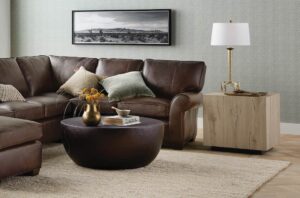The dilemma of choosing between Home Reserve vs Burrow has become increasingly common as e-commerce gains traction in the furniture industry. Consumers are now placing a premium on quality and flexibility when selecting pieces for their living spaces.
Both Home Reserve, a brand with roots in healthcare and educational seating, and Burrow, a newer brand focusing on higher quality furniture, offer compelling options.
This article aims to dissect the offerings of these two brands to help you make an informed decision.
Comparison Home Reserve vs Burrow
| Features/Aspects | Home Reserve | Burrow |
|---|---|---|
| Founded | Transitioned to e-commerce in 2000 | Founded in 2016 |
| Headquarters | Fort Wayne, Indiana | New York City, New York |
| Specialization | Previously designed seating for public sectors | Focus on higher-quality furniture |
| Product Line | Sofas, sectionals, love seats, chairs, ottomans | Sofas with modular designs |
| Unique Features | Built-in storage, replacement fabrics | Modular, Moveable Chaise, built-in USB charger |
| Quality | Durable, modular, customizable | Innovative modular design, concerns about durability |
| Recognition | The Cincinnati Post, UPS, Country Almanac, Better Homes and Gardens | Positive feedback on comfort, style, durability |
| Shipping Time | Average 12-15 days | Varies, most within four weeks |
| Shipping Costs | Not specified | Free within contiguous U.S. |
| Return Policy | 30-day full refund, including shipping charges | 30-day refund minus shipping and 10% restocking fee |
| Warranty | Not specified | One year on Burrow-manufactured pieces |
| Manufacturing Location | Fort Wayne, Indiana, U.S.-sourced materials | Primarily in North Carolina, USA |
| Customer Feedback | Affordability, suitability for small spaces | Comfort, style, durability, some mention lengthy delivery times |
| Additional Pros | Machine-washable cushions and covers | Tests for pet-friendliness, free swatches |
| Additional Cons | Not specified | Supply chain disruptions, limited color options, requires assembly |
History and Foundation
Understanding the history and foundation of Home Reserve vs Burrow provides valuable context for their current product offerings.
Both companies have unique origins that shaped their respective focuses on quality, affordability, and innovation in the furniture market.
Origin of Home Reserve and its Transition to E-Commerce
Founded in Fort Wayne, Indiana, Home Reserve made a pivotal move to e-commerce in the year 2000. The company was agile enough to recognize the untapped potential of online sales in the furniture sector. A key milestone was its recognition by The Cincinnati Post in 2004 for its furniture featured in TV shows.
This offered the brand a boost in visibility. Moreover, the company introduced a new line of products specifically designed for easy shipping in flat-packed containers. This innovation was acknowledged by UPS in April 2005, lauding their effective shipping efforts.
Note: The shift to e-commerce enabled Home Reserve to capitalize on a wider audience, making its unique products accessible beyond the state of Indiana.
Initial Focus of Home Reserve in Healthcare and Educational Sectors
Before transitioning to e-commerce, the founders of Home Reserve had considerable experience in designing seating products for public lobbies in healthcare and educational sectors.
The company’s history in these sectors influenced its approach to durability and functional design. It’s not surprising that their furniture exhibits a blend of comfort and utilitarian design, serving multiple purposes including built-in storage.
The Founding Vision of Burrow and its Differentiation Strategy
On the other hand, Burrow emerged in 2016 with its headquarters in New York City. The company was founded with a vision to fill a gap in the furniture market—offering high-quality pieces at reasonable prices. Distinctly, the brand has a showroom in Manhattan, New York.
Unlike Home Reserve, Burrow was newer to the market but aimed to set itself apart by focusing on modular designs that could fit through tight doorways and were easy to move.
Some users have expressed concerns about the durability of these modular components, which has been a point of focus for the company.
Note: Burrow tests its products for pet-friendliness and also offers built-in USB chargers, making it clear that the company pays attention to the little details that can enhance user experience.
In summary, while Home Reserve evolved from a background in commercial furniture, Burrow entered the market with a focus on consumer-centric, high-quality modular designs.
Both brands, however, have shown adaptability and innovation in their respective market strategies.
Product Range and Special Features
Both Home Reserve and Burrow offer a diverse selection of furniture items designed to meet different needs and preferences. However, each brand has unique features that set its products apart in the highly competitive e-commerce furniture landscape.
From Home Reserve’s built-in storage solutions to Burrow’s focus on modularity and high-tech add-ons, the variety is quite impressive.
Types of Furniture Offered by Home Reserve
Home Reserve primarily offers sofas, sectionals, armchairs, and ottomans. Each category provides a range of options in terms of size, material, and color.
Particularly, their sofas are a big hit, available in various configurations like two-seater, three-seater, and corner sections.
- Sofas
- Sectionals
- Armchairs
- Ottomans
Unique Characteristics of Home Reserve Products, Like Built-In Storage
Home Reserve’s most striking feature is the built-in storage found in most of their seating products.
This feature provides a practical solution for homes with limited space. The under-seat compartments are sizable enough to store blankets, books, and even seasonal items.
Additionally, all Home Reserve products come with renewable parts, which means cushions and covers can be easily replaced.
Note: Built-in storage is not just an add-on but a well-integrated feature that adds value to the product.
Burrow’s Offering with a Focus on Modular Designs
Burrow’s selection is much more centered around modularity. They offer a range of sofas, loveseats, and sectionals that can be easily customized to fit various spaces.
The brand also sells home accessories such as rugs, coffee tables, and wall art to complement their furniture.
- Sofas
- Loveseats
- Sectionals
- Home Accessories
Special Features of Burrow Including USB Ports and Moveable Chaise
One of Burrow’s most appealing features is the built-in USB port available in many of its products. This tech-savvy addition enhances convenience for the modern user.
Additionally, they offer the flexibility of a moveable chaise, which can be easily switched from one end of a sectional to another, thereby allowing for various configurations to fit different room setups.
Note: The moveable chaise and built-in USB ports are unique features that cater to the needs of a younger, more tech-oriented audience.
The unique characteristics of each brand become the key to understanding their market focus and, by extension, their appeal to different consumer groups.
Home Reserve targets those who seek practical solutions and lasting quality, while Burrow appeals to those looking for modern, customizable, and tech-integrated options.
Quality and Durability
Both Home Reserve vs Burrow prioritize quality and durability in their furniture designs, albeit with different areas of emphasis.
Home Reserve is known for its modular design and washability features, while Burrow faces some user concerns regarding durability. It’s essential to scrutinize the quality of materials used by both brands to make an informed decision.
Home Reserve’s Recognition for Quality and Modular Design
Home Reserve is recognized for its commitment to quality, primarily through its modular design. The ability to disassemble and reassemble furniture makes it easier for transportation and setup.
Moreover, the brand uses renewable parts, which facilitates easy replacement of worn-out components, thereby extending the lifespan of the product.
Washability and Maintenance Features of Home Reserve Products
The washable feature in Home Reserve products is particularly laudable. Covers can be easily removed and machine washed, making maintenance a breeze.
This feature is highly beneficial for families with children and pets, as it allows for easy cleanup in case of spills or stains.
Note: The washability feature does more than just simplify maintenance; it also potentially extends the lifespan of the product by enabling regular cleaning without degradation.
User Concerns Regarding the Durability of Burrow Furniture
While Burrow offers visually appealing designs, some users have raised concerns about the brand’s durability. Issues have been noted with the frame and the longevity of upholstery, especially when used frequently.
Comparing the Quality of Materials Used by Both Brands
| Material | Home Reserve | Burrow |
|---|---|---|
| Frame | Hardwood | Plywood |
| Upholstery | Fabric | Leather/Fabric |
| Cushioning | High-density foam | Memory Foam |
Both brands use reputable materials, but the choice between them depends on individual preferences and needs. Home Reserve uses hardwood frames and high-density foam for better support and durability.
On the other hand, Burrow offers options in both fabric and leather upholstery, and their use of memory foam provides a plush feel.
Understanding these key features of quality and durability can significantly assist in making an educated furniture purchase.
Shipping and Return Policies
Both Home Reserve vs Burrow understand the critical role of shipping and return policies in the customer’s decision-making process.
Home Reserve offers an average shipping time along with a full refund policy and 30-day trial. Conversely, Burrow provides free shipping but with certain considerations regarding delivery times and return fees.
Average Shipping Time for Home Reserve Orders
Customers of Home Reserve can generally expect their orders to be delivered within 2-3 weeks. This time frame may vary depending on the availability of the items ordered and the shipping location. Tracking information is usually provided for better transparency.
Home Reserve’s Full Refund Policy and 30-Day Trial
Home Reserve shows confidence in its products by offering a full refund policy coupled with a 30-day trial period. If a customer is not satisfied with their purchase within this time, they are eligible for a full refund, minus the cost of return shipping.
Note: The 30-day trial provides the customer an ample opportunity to assess the product’s comfort and suitability for their space.
Burrow’s Free Shipping Offer and Affected Delivery Times
Burrow offers free shipping on all its products. However, it’s crucial to note that delivery times may be affected by various factors such as high demand or supply chain issues.
A common time frame for delivery ranges from 3-7 business days, but this can extend during peak shopping seasons.
Return and Restocking Fees Associated with Burrow
Unlike Home Reserve, Burrow has certain conditions regarding returns. A restocking fee of 10% is applied, and this does not include the cost of return shipping. Returns must be initiated within 30 days of delivery, and the product must be in its original condition.
| Policy Points | Home Reserve | Burrow |
|---|---|---|
| Shipping Time | 2-3 weeks | 3-7 days |
| Trial Period | 30 days | N/A |
| Return Fees | Cost of shipping | 10% restocking fee + shipping cost |
Being aware of these policies will guide prospective buyers in making a calculated choice based on convenience and assurance.
Key Differences
Home Reserve vs Burrow both occupy significant positions in the furniture market, but their approaches to product design and customer service differ in various ways.
Here, we spotlight these key differences, ranging from product versatility and built-in storage options to return policies and customer satisfaction guarantees.
Contrasting Home Reserve and Burrow in Terms of Product Versatility
Home Reserve focuses on offering a variety of furniture types, including sofas, sectionals, and armchairs, all with the added feature of built-in storage.
Burrow, on the other hand, emphasizes modular designs that allow for easy customization and adaptability but may offer fewer types of furniture.
Built-in Storage Options vs Modular Component Structure
While Home Reserve integrates storage options into its furniture, Burrow adopts a modular component structure, allowing you to configure the furniture according to your needs.
Home Reserve’s built-in storage adds value by maximizing space utilization. Burrow’s modular approach offers flexibility but might not provide the same level of practical storage solutions.
Note: Both brands offer something unique; your choice will depend on whether you prioritize storage or adaptability.
Return Policies and Customer Satisfaction Guarantees
In terms of return policies and customer satisfaction, Home Reserve offers a 30-day trial with a full refund policy. Burrow, while also offering a 30-day return window, imposes a 10% restocking fee and doesn’t cover the cost of return shipping.
| Points of Comparison | Home Reserve | Burrow |
|---|---|---|
| Product Versatility | Multiple types with storage | Modular designs |
| Storage vs Modular Structure | Built-in storage | Modular components |
| Return Policies | 30-day full refund | 30-day, 10% restocking fee |
Understanding these differences can guide consumers in aligning their purchasing decisions with their specific needs and preferences.
Which is Better
The ultimate question at the forefront of any consumer’s mind is: which brand offers a better product?
The answer to this hinges on multiple factors such as value for money, suitability for specific needs, and overall features. We aim to address each of these points to provide a comprehensive view.
Assessing Which Brand Offers Greater Value for Money
Home Reserve presents a strong case for value with its built-in storage features and a 30-day full-refund policy. Burrow, although somewhat similar in pricing, imposes a 10% restocking fee, making returns a bit costlier.
| Brand | Initial Cost | Value-added Features | Return Policy |
|---|---|---|---|
| Home Reserve | Competitive | Built-in Storage | 30-day full refund |
| Burrow | Competitive | Modular Design | 30-day, 10% restocking fee |
Suitability of Each Brand for Specific Needs Like Small Spaces or Pet-friendly Furniture
For those with limited space, Home Reserve’s built-in storage is a strong selling point. On the other hand, Burrow’s modular designs can be particularly useful for those who frequently rearrange their living spaces.
As for pet owners, Home Reserve offers washable fabrics, making maintenance easier.
Note: Your specific needs play a significant role in determining which brand is a better fit for you.
Final Recommendations Based on Overall Features, Quality, and Customer Feedback
Both brands have their merits. Home Reserve excels in practical storage solutions and washability, making it well-suited for families and pet owners. Burrow’s modular design appeals to those seeking flexibility in furniture configuration.
Customer feedback for both brands is generally favorable, although there are some concerns about the durability of Burrow’s products.
In the final analysis, the “better” brand is contingent upon individual preferences and needs. It’s essential to weigh these factors to make an informed decision.
Conclusion
We have scrutinized both Home Reserve vs Burrow, dissecting their history, product range, quality, shipping policies, and key differences. This in-depth evaluation offers prospective furniture buyers valuable insights to make an informed decision.
As the furniture market continues to evolve, driven by consumer demands and technological advances, understanding the merits and drawbacks of these brands becomes increasingly crucial.





